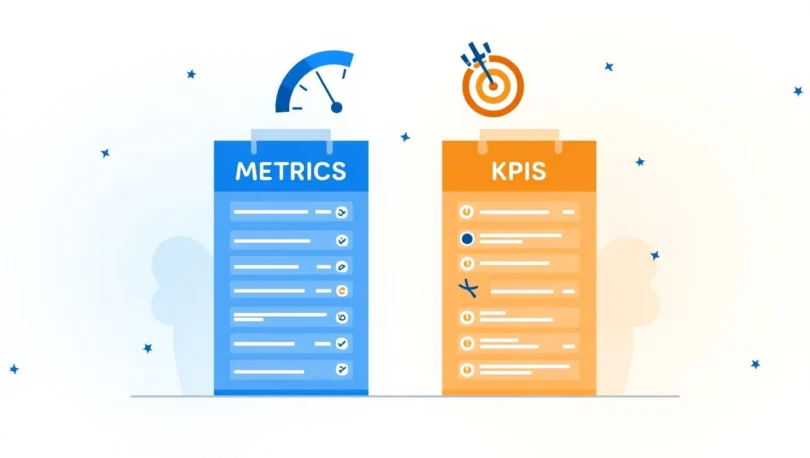When it comes to achieving business success or personal growth, data is your most powerful tool. But with so many numbers and figures to track, it can be easy to confuse metrics with KPIs (Key Performance Indicators). While both are crucial for measuring progress, understanding the difference between them is key to staying on track and reaching your objectives effectively.
In this post, we’ll explore what makes metrics and KPIs different, how they work together, and how you can use them to guide your decisions and actions. Whether you’re running a business, managing a team, or pursuing personal goals, knowing when to use a metric or a KPI will help you focus on what truly matters and keep your efforts aligned with your bigger vision.
Headlines
What Are Metrics and KPIs? (And Why You Need Both)
- Understanding Metrics in Goal Setting
- What Are KPIs? Key Performance Indicators Explained
- KPI vs Metric: The Foundational Difference
10 Key Differences Between Metrics and KPIs
How to Use Metrics and KPIs to Track Goals Effectively
- Setting SMART KPIs for Your Objectives
- Choosing the Right Metrics to Support KPIs
- Real-World Examples of Metrics and KPIs
What Are Metrics and KPIs? (And Why You Need Both)
To reach any goal—whether personal or professional—you need to track your progress. That’s where metrics and KPIs come in. While they’re often used interchangeably, they serve different roles. Metrics give you detailed performance data, while KPIs focus on measuring success toward specific objectives. Understanding both helps you stay focused, make smarter decisions, and move in the right direction with clarity.
Understanding Metrics in Goal Setting
Metrics are the raw numbers — the measurable data points that tell you what’s happening in your day-to-day processes. They track activity, performance, or behavior, but not all metrics are tied directly to your goals. Think of them as the “vital signs” of your operations. They don’t always tell you why something is happening, but they do tell you what is happening.
In the context of goal setting, metrics help you monitor progress, identify trends, and measure efficiency — but without context or a connection to strategic outcomes, they’re just numbers.
💡 Examples of Common Metrics:
- Website visits
- Social media likes or shares
- Email open rates
- Number of tasks completed
- Hours spent on a project
These metrics are useful, but alone, they don’t determine success. For instance, a high number of website visits is encouraging — but does it lead to more conversions, customer engagement, or revenue? That’s where KPIs come in.
📌 Why Metrics Matter in Goal Setting:
- They provide detailed performance data to analyze what’s working and what’s not.
- They act as early indicators — showing patterns before they impact high-level goals.
- They support decision-making by identifying areas for improvement or optimization.
So while metrics don’t define success on their own, they lay the groundwork for evaluating and supporting your KPIs, making them essential to an effective goal-setting system.
What Are KPIs? Key Performance Indicators Explained
While metrics show what’s happening, Key Performance Indicators (KPIs) show what matters most. KPIs are the critical markers of success tied directly to your strategic goals. They measure performance in a way that aligns with your broader objectives—whether in business, personal growth, or project management.
A KPI isn’t just any number. It’s a carefully chosen metric that reflects progress toward a specific outcome. In goal setting, KPIs are what you monitor when you want to stay focused on results, not just activities.
🎯 Example:
Let’s say your goal is to increase online sales.
- A metric might be “number of website visitors.”
- A KPI would be “conversion rate” or “monthly revenue from sales.”
The KPI tells you whether you’re actually moving closer to your goal—not just that something is happening.
✅ Characteristics of a Good KPI:
- Aligned with strategic objectives
KPIs support big-picture goals like business growth, customer satisfaction, or personal development milestones. - Actionable and result-oriented
KPIs point toward action. If a KPI is falling behind, it signals that change or intervention is needed. - Measurable and time-bound
Strong KPIs are tracked over time and tied to a clear timeline or benchmark. Think: “Increase customer retention by 15% in 6 months.” - Few but focused
You don’t need dozens of KPIs. A few focused indicators keep your team (or yourself) aligned and driven.
📌 Common KPI Examples:
- Business Goals:
- Revenue growth
- Net promoter score (NPS)
- Customer acquisition cost
- Monthly recurring revenue (MRR)
- Personal Goals:
- Weight loss progress
- Books read per month
- Daily meditation consistency
- Financial savings targets
In short, KPIs are your performance compass—they don’t just track activity, they define what success looks like. If metrics are the data, KPIs are the story the data tells about your journey toward your goals.
KPI vs Metric: The Foundational Difference
At first glance, KPIs and metrics can seem interchangeable—they both deal with data, they’re both measured over time, and they often appear side by side on dashboards. But here’s the key:
All KPIs are metrics, but not all metrics are KPIs.
This foundational difference lies in their purpose and impact.
🔍 Purpose: Activity vs Outcome
- Metrics track activity. They show what’s happening in your process or system. For example, “email open rate” tells you how many people are opening your emails.
- KPIs, on the other hand, focus on outcomes. They tell you if those emails are helping you achieve a business or personal goal—like “lead-to-customer conversion rate.”
While both numbers are valuable, only one tells you if you’re winning or losing in relation to your goals.
🎯 KPIs Are Tied to Strategy
KPIs are strategic metrics. They’re selected on purpose to reflect your most important objectives. They exist to help you make decisions, adjust your efforts, and stay aligned with the bigger picture.
Metrics, however, are tactical. They help support your KPIs by providing granular insights, but they don’t always reflect progress toward a defined goal.
📊 Example:
Let’s say your goal is to improve customer satisfaction.
- Metric: Number of support tickets received
- KPI: Customer Satisfaction Score (CSAT)
The number of support tickets is helpful—it tells you how many issues were raised. But the CSAT shows whether your customers are actually happy with how those issues were resolved.
⚖️ Think of It Like This:
- Metrics are like ingredients.
You need them to cook the meal, but they don’t guarantee it tastes good. - KPIs are the final dish.
They tell you if the meal turned out right—and if your guests are coming back for more.
By understanding this fundamental difference, you’ll become more intentional with your data. Instead of tracking everything, you’ll focus on what truly drives success, whether that’s for your business, your career, or your personal growth.
10 Key Differences Between Metrics and KPIs
While both metrics and KPIs deal with performance measurement, the differences between them are more than just technical—they’re strategic. Understanding these distinctions will help you track what actually matters, align your efforts with meaningful goals, and avoid data overwhelm.
Below is a breakdown of the 10 most important differences that define and separate KPIs from metrics:
1. Purpose and Focus
- Metric: Tracks general performance data.
- KPI: Measures performance against strategic goals.
KPIs are purpose-driven, while metrics are data-driven.
2. Strategic vs Tactical
- Metric: Tactical — used to monitor daily or operational tasks.
- KPI: Strategic — used to evaluate progress toward high-level objectives.
3. Relevance to Goals
- Metric: May or may not be connected to a goal.
- KPI: Directly tied to SMART goals or business outcomes.
KPIs are goal-sensitive; metrics are goal-agnostic.
4. Actionability
- Metric: Offers insight, but not always actionable.
- KPI: Designed to trigger action when performance dips or excels.
5. Level of Importance
- Metric: Helpful but not always essential.
- KPI: Mission-critical — your success depends on it.
6. Frequency of Use
- Metric: Often tracked continuously or in real time.
- KPI: Monitored at set intervals (e.g., weekly, monthly) for goal tracking.
7. Reporting Visibility
- Metric: Usually included in detailed reports and dashboards.
- KPI: Highlighted in executive summaries and decision-making dashboards.
8. Benchmark and Target Setting
- Metric: May lack targets or thresholds.
- KPI: Always has a benchmark, baseline, or target value to achieve.
9. Business Impact
- Metric: Supports understanding of processes.
- KPI: Reflects overall performance and success.
10. Examples in Practice
- Metric Example: Number of social media shares, email open rates, traffic sources.
- KPI Example: Customer retention rate, net profit margin, sales growth percentage.
✅ Quick Visual Summary
| Feature | Metric | KPI |
|---|---|---|
| Focus | General performance | Strategic goals |
| Purpose | Informational | Decision-driving |
| Tied to Objective | Not always | Always |
| Actionability | Sometimes | Yes |
| Importance | Informative | Critical |
| Use Frequency | Continuous | Scheduled |
| Visibility | Operational reports | Executive dashboards |
| Benchmark Driven | Not necessarily | Always |
| Business Impact | Supportive | High impact |
| Example | Email click-through rate | Monthly revenue growth |
By clearly understanding and applying these differences, you’ll build smarter goal-setting systems, choose the right data to track, and improve your ability to make data-driven decisions that truly move the needle.
How to Use Metrics and KPIs to Track Goals Effectively
Tracking goals isn’t just about collecting data—it’s about using the right data the right way. Metrics and KPIs work best when they’re aligned with your objectives. When you understand how to connect day-to-day metrics with high-level KPIs, you gain a clear path to progress. Let’s break down how to use both effectively to stay focused, measure what matters, and drive real results.
Setting SMART KPIs for Your Objectives
When it comes to turning your goals into measurable success, KPIs are only effective when they’re SMART. That means they’re not just numbers you chase—they’re strategic, structured, and actionable.
The SMART framework (Specific, Measurable, Achievable, Relevant, Time-bound) helps you create KPIs that are both clear and goal-aligned, so you can stay focused on what truly matters in your journey—whether you’re running a business, leading a team, or managing your personal growth.
🎯 Why SMART KPIs Matter
A KPI that isn’t SMART can leave you guessing, make tracking difficult, and ultimately weaken your motivation. But when you apply the SMART principles, you gain:
- Clarity on what success looks like
- Focus on high-priority actions
- Direction for daily decision-making
- Motivation from measurable progress
Let’s break it down:
✅ S – Specific
Your KPI should target a specific outcome or behavior. Avoid vague goals like “do better” or “increase performance.” Instead, get clear:
🔸 Example: “Increase customer satisfaction score”
🡆 Instead of just tracking “feedback,” define which metric you’re improving.
✅ M – Measurable
There must be a clear way to measure progress. If you can’t track it with data, it’s not a KPI.
🔸 Example: “Boost website conversion rate from 3% to 5%”
Use quantifiable values or percentages that make it obvious when you’re improving.
✅ A – Achievable
Your KPI should be challenging but realistic. Stretch goals are good, but setting impossible targets will only discourage your team or yourself.
🔸 Example: “Reach a 10% engagement rate on social media within 60 days”
🡆 It’s ambitious, but still within reason with a good strategy.
✅ R – Relevant
Your KPI must connect directly to a bigger goal or priority. Don’t track things just because you can—track what actually drives results.
🔸 Example: “Improve customer churn rate”
🡆 This KPI matters if your goal is to increase long-term revenue.
✅ T – Time-bound
A KPI without a deadline can drift forever. Time limits bring urgency and accountability.
🔸 Example: “Generate 500 qualified leads in the next 3 months”
Set weekly, monthly, or quarterly timelines depending on the nature of the goal.
🧠 Real-World SMART KPI Example for Goal Setting:
Goal: Grow your online course business.
SMART KPI: “Increase course enrollment rate by 25% within the next 90 days through targeted email campaigns.”
- Specific? ✅ Yes — course enrollment
- Measurable? ✅ Yes — by 25%
- Achievable? ✅ Yes — with a defined marketing channel
- Relevant? ✅ Yes — aligned with growth
- Time-bound? ✅ Yes — within 90 days
By setting SMART KPIs, you create a roadmap that’s not only visible but actionable. It’s how you move from vague ambition to measurable achievement, one step at a time.
Choosing the Right Metrics to Support KPIs
Once you’ve defined your SMART KPIs, the next step is knowing which supporting metrics to track. Think of your metrics as the building blocks that help you understand why a KPI is moving—and how you can influence it.
Not every metric deserves your attention. Some are just noise. But when chosen correctly, the right metrics will help you stay informed, agile, and strategic in your decision-making.
🧭 Metrics as Diagnostic Tools
Imagine your KPI is the “destination” on a map. Your supporting metrics are like signposts and gauges along the way—they tell you how far you’ve come, how fast you’re moving, and where you might be off track.
Example:
- KPI: Improve website conversion rate by 15% in 3 months
- Supporting Metrics:
- Bounce rate
- Average session duration
- Click-through rate (CTR)
- Page load speed These metrics help you pinpoint where users might be dropping off and why they aren’t converting.
🎯 How to Choose the Right Metrics
To support your KPIs effectively, use these guiding principles:
1. Align Metrics with KPI Drivers
Choose metrics that influence or directly affect the KPI.
If your KPI is lead generation, a good metric might be landing page traffic or form completion rate.
2. Track the User Journey
Metrics should follow the path your audience or process takes.
For customer satisfaction KPIs, track metrics like response time, first contact resolution, or support ticket volume.
3. Look at Both Leading and Lagging Indicators
- Leading metrics predict outcomes (e.g., webinar sign-ups before a product launch).
- Lagging metrics reflect outcomes (e.g., actual sales figures after launch).
Balance both to understand progress and future trends.
4. Avoid Vanity Metrics
Don’t be swayed by impressive numbers that don’t drive meaningful change.
10,000 Instagram followers is great—but if your KPI is customer acquisition, it’s more important to track conversion from social clicks.
🛠️ Real-World KPI + Metrics Examples:
| KPI | Supporting Metrics |
|---|---|
| Increase email marketing ROI | Open rate, click-through rate, unsubscribe rate |
| Boost employee productivity | Tasks completed, time spent per task, overtime hours |
| Improve customer retention | Churn rate, customer lifetime value (CLTV), NPS |
| Grow organic website traffic | Impressions, bounce rate, keyword rankings |
| Improve app user engagement | Daily active users (DAU), session duration, feature usage |
⚡ Pro Tip:
When in doubt, ask:
“Will tracking this help me take action toward improving my KPI?”
If the answer is no, ditch it.
Choosing the right metrics to support your KPIs turns your strategy into a living, breathing system—one that’s measurable, adaptable, and grounded in insight.
Real-World Examples of Metrics and KPIs
Understanding the difference between metrics and KPIs is crucial for anyone looking to track progress, whether for personal goals, business objectives, or team performance. Real-world examples help highlight how metrics and KPIs function in various contexts. Here, we’ll explore some common scenarios to show how metrics and KPIs work together and why the distinction matters.
💼 Example 1: E-Commerce Business
KPI: Increase online sales revenue by 20% within the next 6 months.
- Supporting Metrics:
- Website Traffic: Measures how many visitors are coming to the site.
- Average Order Value (AOV): Indicates how much the average customer spends per purchase.
- Conversion Rate: Tracks how many visitors actually make a purchase out of total visitors.
Why these are metrics, not KPIs: While each of these metrics (traffic, AOV, conversion rate) plays a role in improving sales, none of them directly state whether you’re achieving the 20% sales increase goal. They are important pieces of data that help you understand what’s affecting your KPI (sales revenue).
💼 Example 2: Social Media Marketing
KPI: Increase social media engagement by 30% over the next quarter.
- Supporting Metrics:
- Likes and Shares: Shows how much your posts are being interacted with.
- Follower Growth Rate: Measures the speed at which your follower base is growing.
- Comments and Mentions: Indicates how engaged your audience is in conversations.
Why these are metrics, not KPIs: These metrics reflect engagement but don’t directly answer whether your 30% increase goal will be met. The KPI is focused on engagement growth as a specific outcome, whereas the metrics help gauge the performance of specific tactics.
📱 Example 3: Mobile App Development
KPI: Achieve a 4.5-star rating on app stores within 6 months.
- Supporting Metrics:
- Number of App Downloads: Measures how many times the app has been downloaded.
- App Retention Rate: Indicates how many users continue using the app after the first download.
- Crash Rate: Tracks how often the app fails or crashes during use.
Why these are metrics, not KPIs: While the number of downloads, retention rate, and crash rate are valuable metrics that influence your app’s success, they don’t directly indicate if your KPI of reaching a 4.5-star rating is achieved. They are critical for understanding app performance, but the rating itself is the key indicator of success.
🏢 Example 4: Employee Productivity
KPI: Improve employee productivity by reducing average task completion time by 15% over the next 3 months.
- Supporting Metrics:
- Tasks Completed per Week: Measures how many tasks are completed by an employee in a given time.
- Overtime Hours Worked: Indicates whether employees are working additional hours to meet deadlines.
- Employee Satisfaction: Tracks how satisfied employees are, which can affect their productivity.
Why these are metrics, not KPIs: The number of tasks completed, overtime hours worked, and employee satisfaction are indicators that affect productivity but don’t directly measure it. The KPI focuses on reducing task completion time as the direct metric of productivity improvement.
🚀 Example 5: Content Marketing
KPI: Increase organic website traffic by 40% in 6 months.
- Supporting Metrics:
- Blog Posts Published: Shows how often new content is being posted.
- Click-Through Rate (CTR) on Organic Links: Measures how often organic links in search results are clicked.
- Bounce Rate: Indicates how many visitors leave after viewing just one page.
Why these are metrics, not KPIs: While the metrics of blog posts published, CTR, and bounce rate provide valuable insights into content performance, the KPI is the increase in organic traffic. These metrics help improve or explain the traffic, but they don’t define whether the KPI (traffic increase) is achieved.
.
💡 Understanding the Connection Between Metrics and KPIs:
The key takeaway here is that metrics are the tools you use to measure specific activities, while KPIs are the ultimate indicators of success toward a goal. In each example, the KPI defines the outcome you’re working toward, and the metrics tell you how to adjust your strategy to reach that outcome.
Metrics are diagnostic—they provide feedback on processes. KPIs, on the other hand, are outcome-focused—they define whether your efforts are on track.
🔑 Real-World Example Summary Table:
| KPI | Supporting Metrics |
|---|---|
| Increase online sales revenue by 20% | Website traffic, Average Order Value, Conversion Rate |
| Increase social media engagement by 30% | Likes & Shares, Follower Growth Rate, Comments & Mentions |
| Achieve a 4.5-star app rating | Number of Downloads, Retention Rate, Crash Rate |
| Improve employee productivity by 15% | Tasks Completed per Week, Overtime Hours, Employee Satisfaction |
| Increase organic traffic by 40% | Blog Posts Published, CTR, Bounce Rate |
By exploring these real-world examples, it becomes clear that while metrics are essential for tracking performance, only KPIs reflect true progress toward your most important goals. This distinction will guide your decision-making and ensure that you’re focusing on the right data for success.
In summary, while metrics and KPIs are both vital components of a data-driven approach to success, they serve different purposes. Metrics are the individual data points that help you track performance, while KPIs are the critical measurements that indicate whether you’re achieving your most important goals. By choosing the right KPIs and aligning them with relevant metrics, you create a powerful system that helps you measure success accurately and make informed decisions.
Remember, KPIs provide the clear outcomes you’re working toward, and metrics help you track the actions that get you there. Understanding the distinction between these two will allow you to optimize your strategy, improve your performance, and, ultimately, reach your objectives more effectively.
So next time you set a goal, make sure you’re not just tracking any data—track the right data, and you’ll be that much closer to achieving success.
Recommended: Key Performance Indicators: The Secret to Smarter Goal Achievement








Leave a Comment